- Elon Musk‘s brain-computer interface company, Neuralink, has implanted into a first human patient.
- Musk says the goal is for us all to control our phones and computers with our minds.
- His competition from other BCI makers, who’ve been implanting for decades, is steep.
Elon Musk announced his brain interface company, Neuralink, implanted its first human brain chip last week. The product is called “telepathy.”
“Enables control of your phone or computer, and through them almost any device, just by thinking,” Musk said on X, the social media platform he owns, which is formerly and better known as Twitter.
Given all the breathless discourse about this being a “first” in human brain implantation, you’d be forgiven for assuming Musk is far ahead of the competition.
But surgically implanted brain-computer interface devices, or BCIs, have been going into people’s heads for about twenty years now, ever since a pioneering surgery took place in Massachusetts in 2004. Since then, multiple companies have popped up with increasingly elegant and useful BCIs, arguably well ahead of where Neuralink stands today with a single, first surgery.
Here’s how Musk’s stiffest competition stacks up right now:
1. Blackrock
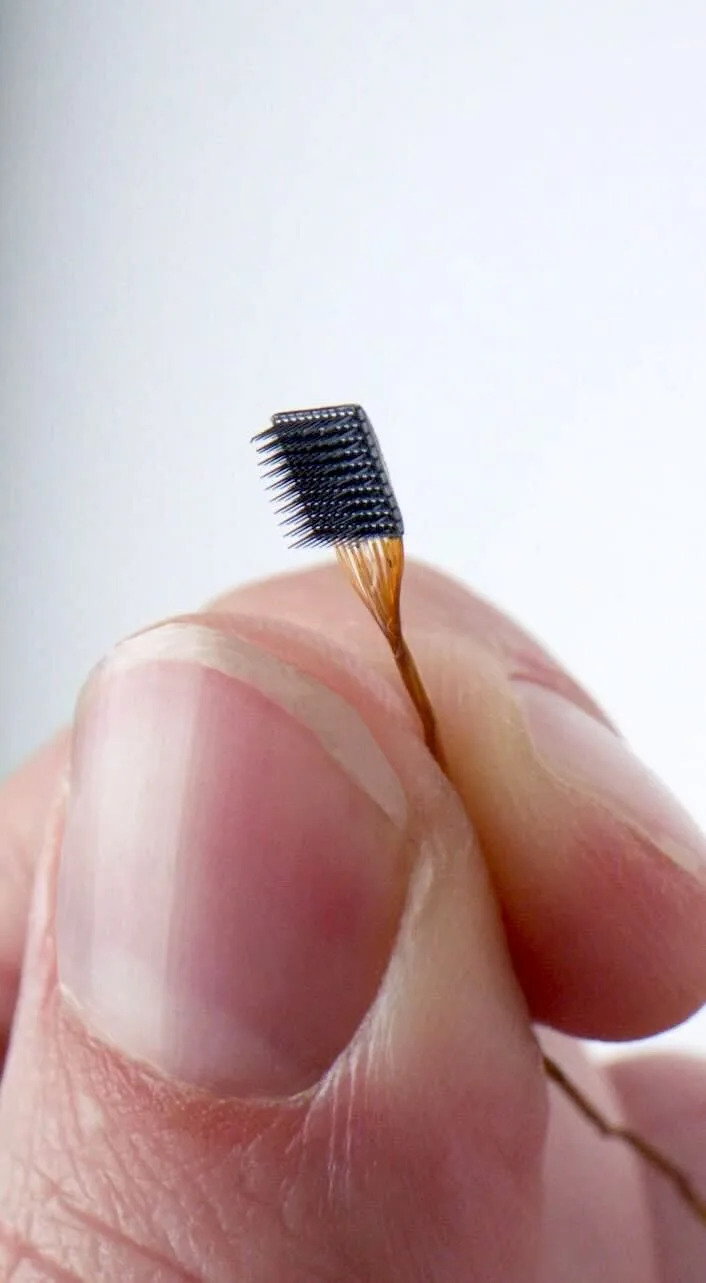
Blackrock’s implantable electrode, called the Utah Array, is smaller than your thumbnail.Courtesy of Blackrock Neurotech
Today, most people who have a BCI implanted in their head have a Blackrock device. Precise numbers are hard to come by, but the best evidence suggests there are fewer than 50 people worldwide with a BCI implanted in their skull. About 40 of those are Blackrock products.
Blackrock Neurotech (not to be confused with the completely unrelated Blackrock investment firm) has been at this for a while. Headquartered in Utah, the company was founded in 2008.
For now, all implanted BCIs are a way for people with severe forms of paralysis to regain independence, using their thoughts to control devices and access the internet.
A couple of people with Blackrock implants can use their BCI to drive a car. Others have restored a sense of touch. But executives in this space say that in the future, applications for BCIs could look very different. Blackrock co-founder Florian Solzbacher has said the revolutionary tech may one day be used by first responders, military, or other able-bodied people looking to win a competitive edge or some extra convenience.
Blackrock CEO Marcus Gerhardt told Business Insider that, while still a ways off, “the possibility of breaking that barrier will come maybe sooner than people out there believe.”
2. BrainGate
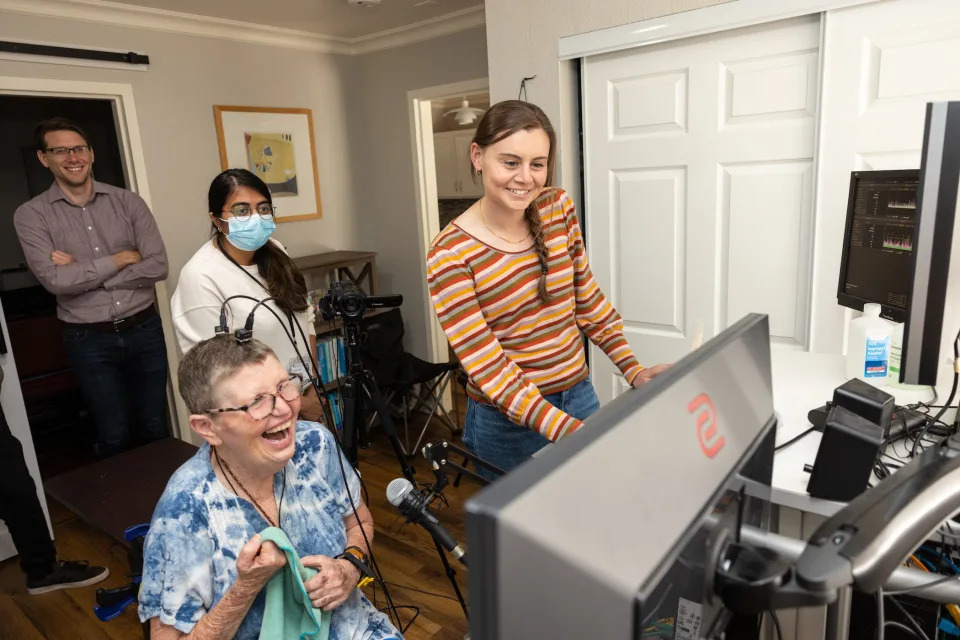
Pat Bennett was diagnosed with ALS in 2012. The neurodegenerative condition rendered key muscles in her face limp, but a BCI device is helping her communicate again.Steve Fisch/Stanford Medicine
BrainGate pioneered the very first implanted BCI for human use in 2004, building on research that started at Brown University in the late 1990s. The academic consortium’s current device is typically about “the size of a baby aspirin,” and is manufactured by Blackrock.
Each patient’s implant consists of two or more devices, each with up to 100 thinner-than-hair electrodes. It’s implanted on the surface of the brain, atop the cortex, in areas responsible for limb movements or speech.
The very first BrainGate device — which was the first-ever implanted BCI — was put into the head of Matthew Nagle, a man who was paralyzed from the neck down in a stabbing attack. Nagle became a formidable Pong video game player using his BCI, but died in 2007 after developing sepsis. Three more patients had the same first-generation BrainGate BCI implanted from 2004-2009.
“You don’t necessarily read as much about them and they don’t tend to hog the public limelight, but that’s because they’re focused on doing fundamental and profound research in this space,” Gerhardt said of the BrainGate consortium.
BrainGate is now running a clinical trial of their second generation BCI, a device for tetraplegics like Nagle called BrainGate2. The trial, ongoing since 2009, is expected to end in 2038. So far, there are 15 people with BrainGate2 devices.
“Each amazing participant in the trial contributes an extraordinary amount to the field, often engaging in the trials with us for years and providing feedback on how these types of implantable BCIs will help other people with paralysis,” BrainGate clinical trial lead Dr. Leigh Hochberg told Business Insider in an email.
3. Synchron
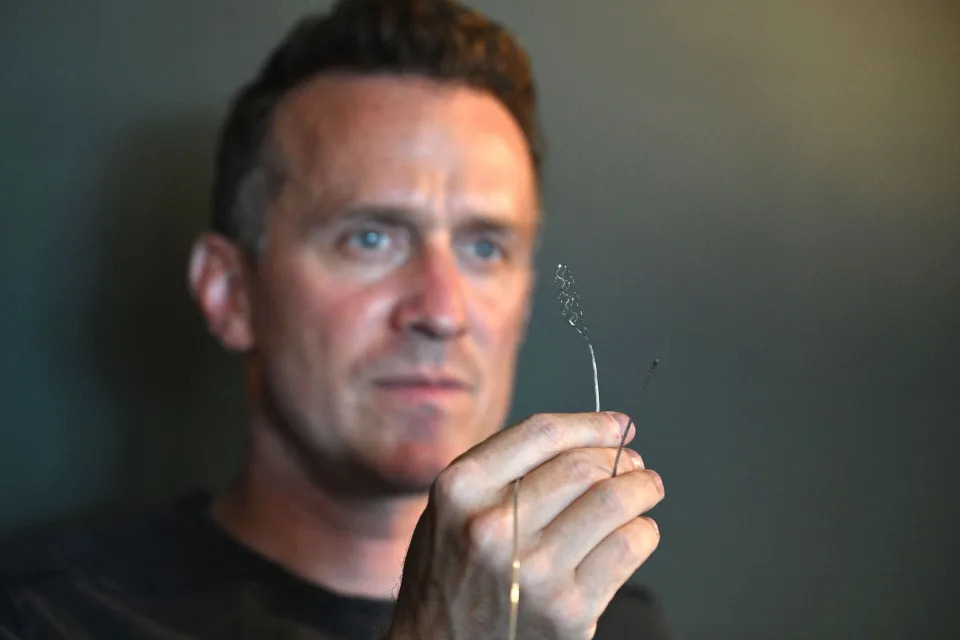
Synchron CEO and founder Dr. Thomas Oxley holding the company’s stentrode BCI.Angela Weiss/AFP via Getty Images
Brooklyn-based Synchron has developed one of the tiniest, most minimally invasive BCIs, and implanted it successfully into several people around the world, including patients in Australia (2020) and the US (2022). Instead of being plopped on top of the brain’s grey matter, like many other BCI devices, Synchron’s stentrode sits inside of blood vessels in a person’s head.
This BCI is funneled into the head via a tiny metallic, mesh stent. In much the same way that heart disease patients often use stents to pry open blocked arteries near their hearts, Synchron implants a small scaffolding of electrodes into key blood vessels at the top of the skull near our motor cortex, to transmit thoughts into actions. A pacemaker-like unit in the chest then translates those signals from the brain wirelessly to a computer or device.
In 2022, Musk — then reportedly frustrated by Neuralink’s slow pace of development — reached out to Synchron’s CEO, neurosurgeon Thomas Oxley, about investing in the company, Reuters reported. And Musk’s co-founder, former Neuralink president Max Hodak, is a Synchron investor. Though Hodak once told Bloomberg he didn’t want his investment in a Neuralink rival to be seen as a “knock” on his former company.
“I’m sure they will also get into humans soon,” he said.
4. Academic institutions around the globe
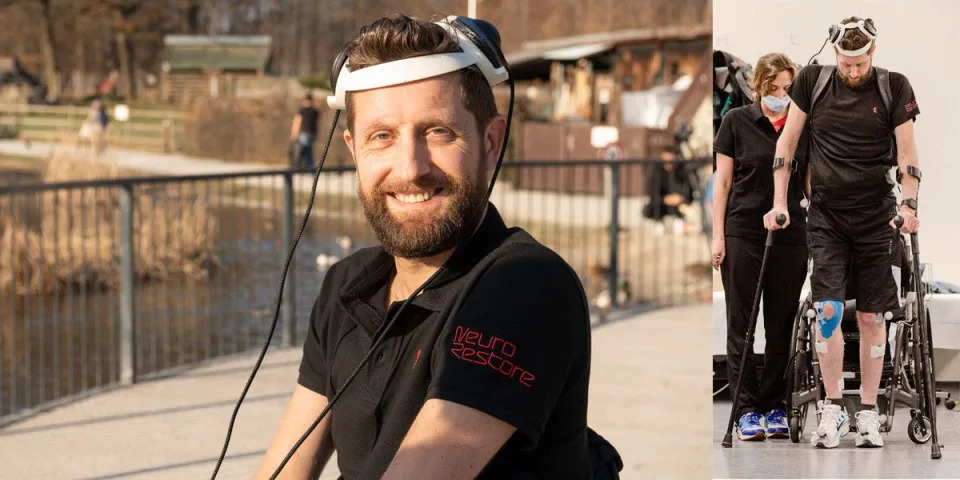
NeuroRestore / Onward
Several other universities are also leading the BCI charge, with one-off research surgeries. Some are visible plugs that sit on top of people’s heads and require a wired hookup to a computer to read brain signals. At least one man uses a backpack to transmit signals from two BCI electrode grids inside his head to another implant in his spine, helping him walk.
Canadian Ann Johnson, unable to speak for nearly 20 years after a stroke, is regaining her ability to talk with an implanted BCI from the University of California, San Francisco. Dutchman Gert-Jan Oksam is the guy with a backpack who can walk again after a biking accident hit his spinal cord, thanks to researchers at Lausanne University in Switzerland.
“I’m not walking to the grocery market yet, but I can for sure stand way better now,” Oksam told reporters during a press conference in May.
“It’s still hard to walk,” he said. “But I’m very happy I’ve achieved what I achieved.”
What Neuralink has to prove
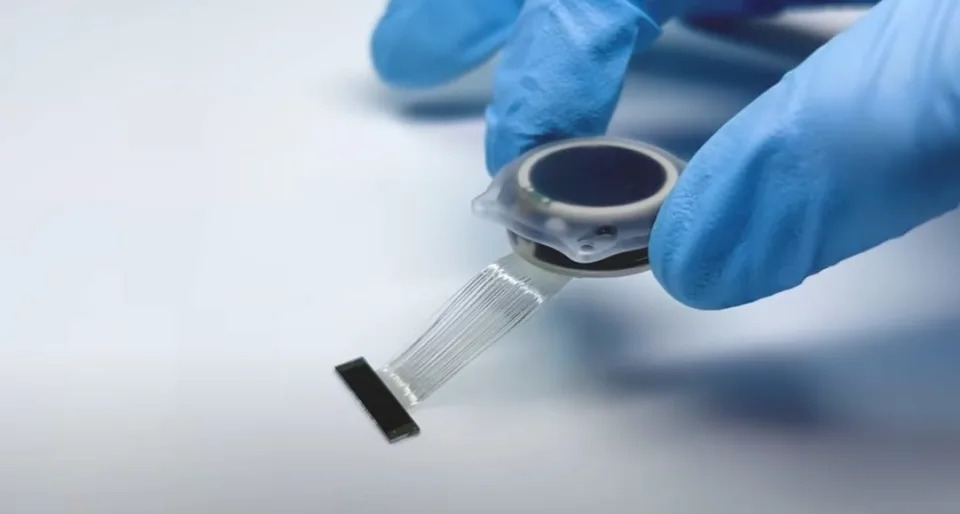
Neuralink via YouTube
What Neuralink has done so far is merely a first step in pulling off an operational BCI. The California–based company put its “cosmetically invisible” device inside of a person’s brain in late January. Musk has told reporters that he expects this first patient will be able to control a computer or phone using only their mind in about a week.
“Let Elon be Elon, and he can help us envision the future and challenge us to step outside our framework and limiting constructs and think about what might be possible one day,” Gerhardt, the Blackrock CEO, said. “At the end of the day, the devil will be in the details, and we’ll just have to see.”
Fundamentally, Neuralink’s technology isn’t that different from Blackrock’s. Instead of looking like a tiny comb, though, the Neuralink device has over 1,000 fine, hair-like electrodes distributed in 64 threads, likely a more formidable surgical challenge.
(Neuralink study details, posted online, say the company has designed a surgery robot “to reliably and efficiently insert the threads of the N1 Implant into the appropriate region of the brain.” It’s unclear how much of Neuralink’s surgery procedure is done by a human.)
The next challenge is to prove this device can help someone regain some independence. For example, can this BCI help a person with ALS (or, Locked-in Syndrome) shop online?
“Initial users will be those who have lost the use of their limbs,” Musk said on X. “Imagine if Stephen Hawking could communicate faster than a speed typist or auctioneer. That is the goal.”
That goal isn’t out of the question, but it will take some years, and some level of training. We should know a little more within the next few days or weeks about how well the first Neuralink patient is recovering.
“How we think, how we feel, how we experience — this is much more than just an engineering problem,” neuroscientist Anil Seth recently told the BBC. “The kind of strategy that Musk has found so successful in building electric cars or rockets, I don’t think it transfers smoothly over to this domain.”
Read the original article on Business Insider













Got a Questions?
Find us on Socials or Contact us and we’ll get back to you as soon as possible.